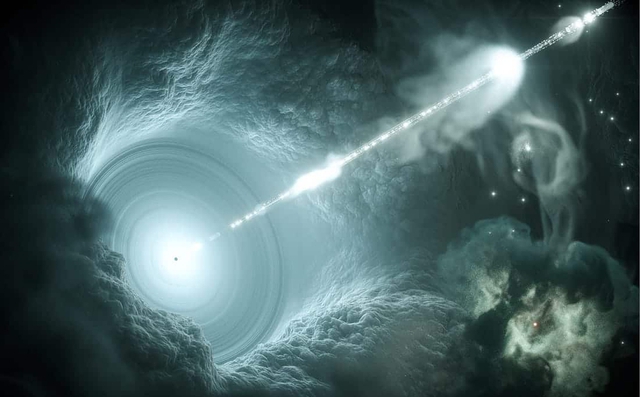What can travel faster than light? Science comes in, unexpected results!
The speed of light traveling through a vacuum is 299,792,458 meters/second, denoted by c. This is an important fundamental physical constant in many areas of physics. So, how was the speed of light discovered, and is there anything, in fact, that could be faster?
In 1676, by studying the motion of Jupiter’s Moon, the Danish astronomer Ole Romer calculated that light travels at a finite speed. According to the American Museum of Natural History, New York City, by 1678, based on data from Ole Romer, Dutch mathematician and scientist Christiaan Huygens became the first person to attempt to determine the real speed. economy of light.

Speed of light
Mr. Christiaan Huygens put the figure at 211,000 km/s. This is an inaccurate number by today’s standards, especially after scientists measured the speed of light in a vacuum to be about 299,792 km/s. However, Huygens’ calculations also show that light travels at amazing speeds.
In fact, according to Albert Einstein’s theory of special relativity, light travels so fast in a vacuum that nothing in the universe can travel faster.
“We can’t travel in a vacuum of space faster than the speed of light,” said Jason Cassibry, an associate professor of aerospace engineering at the Center for Thrust Research at the University of Alabama.

According to Albert Einstein, light travels in a vacuum so fast that nothing in the universe can be faster. Photo: Getty Images
The question arises that when light is not in a vacuum, is the above statement still true?
According to theoretical physicist Clauda de Rham at Imperial College London, the very assertion that ‘nothing can travel faster than the speed of light’ is technically incorrect, at least in the medium. non-vacuum.
Because of the fact that light exhibits both particle and wave-like properties, it can therefore be thought of as both a particle and a wave. This is called wave-particle duality.
According to expert Clauda de Rham, if we consider light as a wave, there are many reasons why some waves can travel faster than white or colorless light in a certain medium.
Specifically, one such reason is that when light travels through a medium, such as glass or a drop of water, different frequencies or colors of light travel at different speeds.
According to a post from the University of Wisconsin-Madison, the most obvious visual example of this happens in a rainbow. Accordingly, rainbows typically have longer and faster red wavelengths at the top, while purple wavelengths are shorter and slower at the bottom.
But when light travels through a vacuum, this is no longer the case.
“All light is a type of electromagnetic wave and they travel at the same speed in a vacuum,” explains Rhett Allain, a professor of physics at Southeast Louisiana University. and gamma rays have the same speed”.
What can travel faster than light?

The speed of light is 299,792 km/s. Photo: Getty Images
Therefore, according to physicist Clauda de Rham, the only thing capable of traveling faster than the speed of light is the light. This may sound a bit paradoxical, but it can happen only when not in the vacuum of space. However, no matter what environment it is in, light will never exceed its maximum speed of 299,792 km/s.
However, according to Associate Professor Jason Cassibry, there are several other points to consider when discussing things that move faster than the speed of light.
“There are parts of the universe that are expanding and moving away from us at speeds faster than the speed of light, because space-time is expanding,” said Associate Professor Jason Cassibry.
For example, the Hubble space telescope recently detected light 12.9 billion years old from a distant star called Earendel. But because the universe is expanding at every point, Earendel is moving away from Earth. This star has moved like that since its formation and is currently 28 billion light-years away from Earth.
So, in this case, space-time is expanding, but matter in space-time is still moving within the limits of the speed of light.
Obviously nothing travels faster than light as we know it. But is there actually a situation where this could happen? Einstein’s special and general relativity are built on the principle that the concepts of space and time are relative.
According to physicist Clauda de Rham: “We can imagine the transmission of information at the speed of light through systems outside the solar system. But transporting people at the speed of light is not possible. , because we can’t accelerate ourselves to that speed”.
Clauda de Rham further emphasizes that, even in ideal conditions, where people are capable of continuously accelerating themselves at a constant rate, even ignoring how to get technology to speed them up. continuously, humans will never truly reach the speed of light.
“We can get close, but we’ll never get there,” said Clauda de Rham.
Associate Professor Jason Cassibry also agrees with this idea. Mr. Jason Cassibry said: “Relativity aside, if you accelerate at 1G (Earth’s gravity) it will take you a year to reach the speed of light. But you will never really reach the speed of light. this speed, because as you begin to approach the speed of light, your mass energy will increase and approach infinity.One of the few tricks that can be used is expansion and collection. narrow space-time, thereby pulling the target closer to you”.
There seems to be no fundamental limit to the rate at which space-time expands or contracts. This means we could get close to this velocity limit someday.
Professor Rhett Alllain also said that traveling faster than light is unlikely, but if humans want to explore distant planets, it may not really be necessary to achieve such speeds. so.
According to this professor, the solution if humans want to travel faster than light is to use wormholes.
This doesn’t actually make humans faster than light, but it could provide us with a shortcut to some other location in space. However, this expert also does not know whether it is possible to build a wormhole and how to do it.
Article referenced source: Livescience, Space
at Blogtuan.info – Source: genk.vn – Read the original article here



